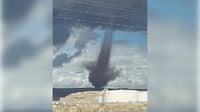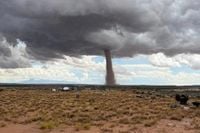Residents of southeastern Utah are reeling after a rare and destructive series of tornadoes tore through San Juan County on Saturday, September 13, 2025, leaving a trail of devastation across the Navajo Nation Reservation and the surrounding communities. While no human injuries have been reported, the storm displaced multiple families, destroyed homes and infrastructure, and highlighted both the vulnerability and resilience of this rural region.
The National Weather Service (NWS) confirmed that two tornadoes touched down near Montezuma Creek over the course of about an hour, beginning around 12:35 p.m. According to meteorologist Kris Sanders from the NWS’s Grand Junction, Colorado office, the tornadoes’ paths likely covered less than 10 miles, though precise tracks and wind speeds have yet to be determined. Sanders told the Associated Press, “Tornadoes are pretty unusual in that part of Utah,” noting that only two have been confirmed in the area since 1950.
For the Navajo Nation, the impact was immediate and severe. President Buu Nygren shared on social media that three homes were demolished in the storm, and as many as 15 to 20 homes were in the tornado’s path. The 27,000-square-mile reservation, the largest of any Native American tribe, stretches into Arizona, New Mexico, and Utah. The Navajo Police Department reported that, while no injuries occurred, an unknown number of livestock and pets are missing. Images posted by the department showed the towering funnel cloud looming over the landscape and the heartbreaking aftermath—a flattened home surrounded by debris.
San Juan County officials described “widespread damage to homes, property, and infrastructure,” as reported by KUTV. In addition to the three destroyed houses, two more suffered significant damage, and several structures—including horse trailers and a hay barn—were obliterated. The tornadoes knocked down power poles, causing multiple outages and leaving the community of Montezuma Creek without electricity. The Navajo Tribal Utility Authority responded swiftly, repositioning power lines in an effort to restore service, but many residents remained in the dark as of Sunday.
For those suddenly without shelter, the response was quick and coordinated. Displaced families were initially taken to Montezuma Creek Elementary School, which served as an emergency shelter. The American Red Cross, local emergency agencies, and the Aneth Chapter House worked together to provide food, accommodations, and support. Eventually, families were moved to nearby hotels as longer-term solutions were sought. Carma Claw, president of the Aneth Chapter, told the Navajo Times, “Primarily first and foremost, there are no injuries reported and there were several structures, homes that were completely destroyed.”
Community members expressed both shock and gratitude following the disaster. For many, it was their first time witnessing such an event. Terrell Benally shared his disbelief with ABC4: “We’ve never had to encounter something like this before. The closest thing to a tornado I’ve ever seen are dust devils.” The visible funnel cloud, stretching from sky to ground in broad daylight, left a lasting impression on all who saw it.
The storm’s reach extended beyond Montezuma Creek. A second tornado was confirmed in the Cahone Mesa area southeast of Blanding, where two homes, a fifth-wheel trailer, two horse trailers, and a hay barn were destroyed, according to the San Juan County Sheriff’s Office. Two additional homes sustained significant damage. Claw explained, “There were several touchdowns. I think there was a count of four, possibly five… starting from McCracken Mesa, which is north of Montezuma Creek… and then further across to Cahone Mesa.”
Delegate Curtis Yanito, a resident of Bluff, Utah, praised first responders for their swift action: “The first responders showed up and they checked on all the families out there.” He added, “I’ve never seen that many tornados all at the same time like this. The weather’s really changed. But I’m glad the first responders did a quick response. I just want to thank them for their work in this community.”
With so many homes and structures damaged or destroyed, the need for emergency shelter and support was pressing. The American Red Cross provided immediate assistance and encouraged residents to use the organization’s emergency app for future warnings. Benjamin Donner, executive director of the Red Cross over Central and Southern Utah, told KUTV, “Things like this can often times create fear, and what would we do? We want to make sure that preparedness will often drive away fear.” He advised, “In a construction home, we want to find the lowest place in the home—preferably without windows… oftentimes that may be a basement; it can be a room in the center of a house.”
The Utah Navajo Health System also stepped in to offer mental health counseling and additional support for those traumatized by the disaster. As the community grapples with the loss of homes, property, and beloved animals, mental health resources are proving as vital as food and shelter.
Officials urged residents to stay away from the hardest-hit areas while assessments continued. The NWS announced that a full survey would be conducted to better understand the tornadoes’ strength and exact paths, with results expected in the coming days. Meanwhile, local authorities continued to monitor weather conditions and warned residents to remain vigilant for further storms.
The rarity of such an event was not lost on anyone. “As far as like the Four Corners are concerned, since about 1950, there’s only been less than half a dozen tornadoes in that area. So, this was kind of a rare event for them,” Sanders explained to KSL. “It was not a weak tornado.”
For many in southeastern Utah, this weekend’s tornadoes have become a somber wake-up call. The American Red Cross hopes the experience will encourage more families to develop disaster plans and stay informed about severe weather risks. As President Nygren put it, the focus now is on recovery and resilience—helping families rebuild and ensuring the community is better prepared for whatever nature throws its way next.
While the full extent of the damage is still being assessed, the outpouring of support—from first responders to local agencies to neighbors helping neighbors—has offered a measure of hope amid the wreckage. The tornadoes may have been rare, but the spirit of the community has proven to be anything but.


